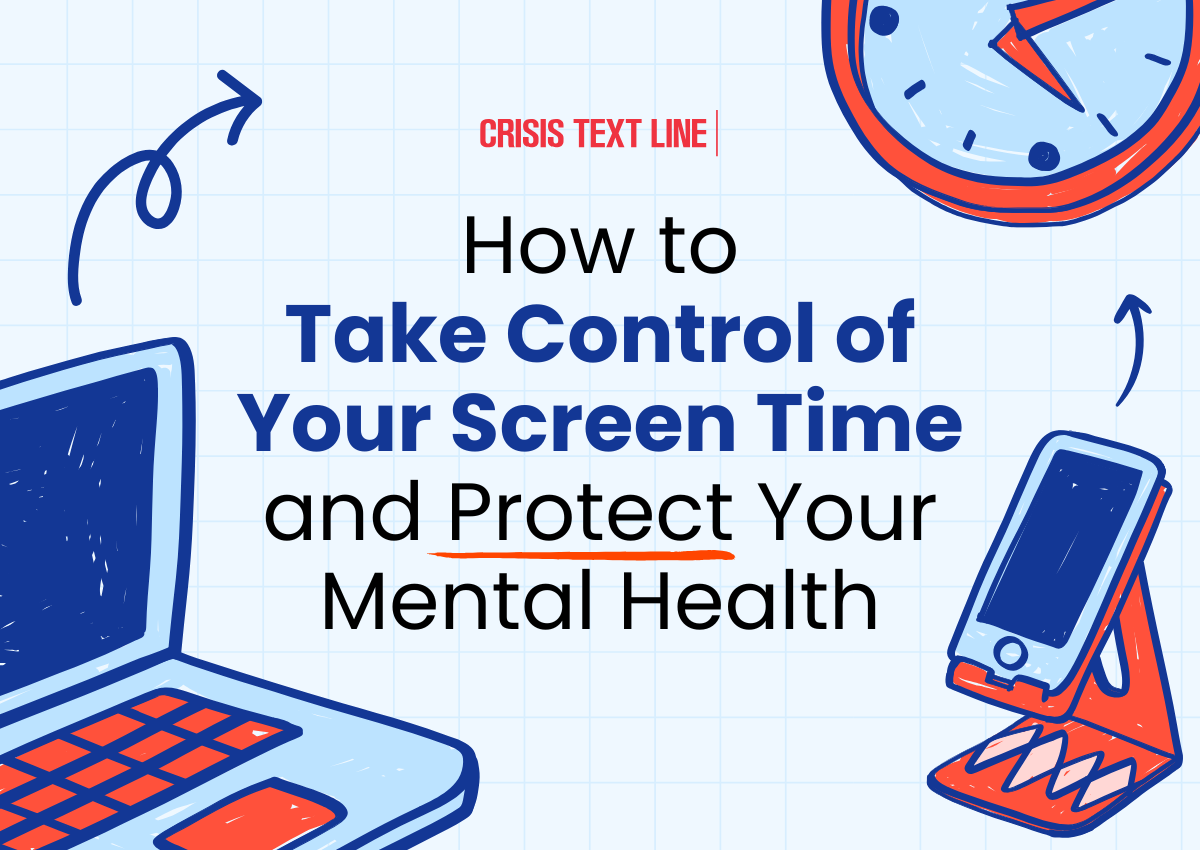How to Take Control of Your Screen Time and Protect Your Mental Health

Our smartphones are more than just communication tools. They are our go-to for news, entertainment, and staying connected with friends and family. But if you’ve ever found yourself endlessly scrolling through social media, consuming bad news, updates about others’ lives, and trending topics, you’re not alone. This habit, known as doomscrolling, can negatively impact your mental health, increasing stress, anxiety, and symptoms of depression.
Surgeon General Dr. Vivek Murthy has highlighted the widespread effects of excessive social media use, pointing to its role in increasing stress, isolation, and disrupted sleep. Dr. Murthy cautioned that prolonged digital engagement fuels anxiety and urges stronger protections, especially for young people, to foster healthier digital habits and real-world connections.
If you or someone you know is overwhelmed by doomscrolling, Crisis Text Line is here to help. Text CONNECT to 741741 to chat with a live volunteer Crisis Counselor for free and available 24/7.
How social media affects your mental health
Social media isn’t all bad! Here are some benefits:
- Staying connected to others – Social media helps maintain relationships with friends and family, even across long distances.
- Access to information – It provides real-time news updates and diverse perspectives.
- Creative expression – Users can share their ideas, talents, and experiences with people around the world.
However, spending too much time online can come with some significant downsides:
- Constant comparison – Seeing curated highlights of others’ lives can lead to low self-esteem or make you feel worse about yourself.
- Feedback loops – Constantly checking for likes and comments can create an unhealthy dependence on social validation.
- Information overload – Consuming negative news excessively can increase anxiety and depression.
- Disrupted sleep – Excessive screen time, especially before bed, can interfere with rest and real-world social connections.
- Reduced in-person interactions – Spending too much time scrolling can replace meaningful, real-world interactions with family and friends.
Research from Pew Research Center shows that social media is deeply woven into society with nearly 70% of adults and over 80% of teens being active users. This widespread use raises concerns about the potential negative impacts on mental health and well-being across generations, including increased feelings of anxiety and depression. Learn more about depression, or seek support on how to navigate the symptoms, by clicking here.
What is doomscrolling?
Doomscrolling is the habit of endlessly consuming negative news and content, which can leave people feeling anxious or drained. Our brains are wired to focus on threats, and social media algorithms amplify this by prioritizing distressing content. While staying informed is important, recognizing doomscrolling as a habit is the first step toward breaking free.
Scrolling addiction is common, as social media platforms are designed to keep us engaged with endless content. Fear of missing out (FOMO) can make it difficult to stop. Unlike intentional news consumption, mindless scrolling often leaves people feeling worse rather than informed. Asking yourself whether you’re scrolling out of curiosity or compulsion can help end the cycle.
I want to scroll less, but I don’t know where to start
Breaking the cycle of doomscrolling is possible with intentional habits. Here are some steps you can take:
Set time limits for viewing news and social media content
- Use your phone’s built-in screen time tracker to monitor usage.
- Set app limits or schedule “no-scrolling” times throughout the day.
- Limiting social media time to just half an hour a day can lead to improvements in mental health.
Control your feed to make the content healthier
- Unfollow or mute accounts that constantly post negative or distressing content.
- Follow uplifting, informative, and inspiring pages to create a more balanced online experience.
Replace scrolling with other activities
- Take a walk outside and enjoy nature.
- Exercise to shift your focus from screens to movement.
- Read a book, listen to music, or start a new hobby.
- Spend quality time with family and friends at a favorite spot such as a park or coffee shop.
Use technology intentionally
- Schedule specific times during the day to check the news instead of letting it consume your day. Don’t let a one-hour lunch break turn into an hour-long scrolling session filled with anxiety.
- Turn off notifications to reduce distractions.
- Move your phone away from your bed to avoid doomscrolling late at night or first thing in the morning.
Break free from doomscrolling and take control of your mental health
Remember, overcoming doomscrolling is a journey and it takes time. Be patient with yourself and give yourself grace. Being mindful of what you consume online can help you feel more in control of your digital habits. Small, consistent changes can significantly improve your mental well-being and help you prioritize your time.
Click here to learn more about doomscrolling, along with practical strategies to build healthier screen time habits and safeguard your mental well-being. For additional support, check out Our 25 Self-Care Activities and Wellness Tips for 2025—a valuable guide to help you prioritize balance and self-care.
You don’t have to navigate the effects of doomscrolling alone. If you’re feeling overwhelmed by negative news or social media’s impact on your mental health, we’re here to help. Text CONNECT to 741741 to reach a trained volunteer Crisis Counselor—available 24/7 and free to support you.

